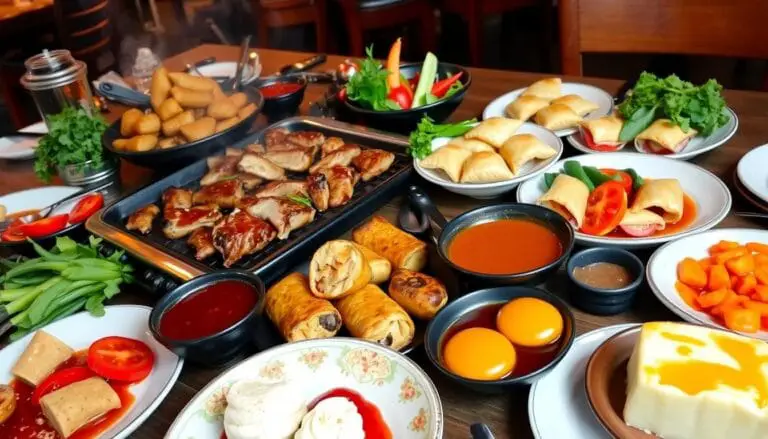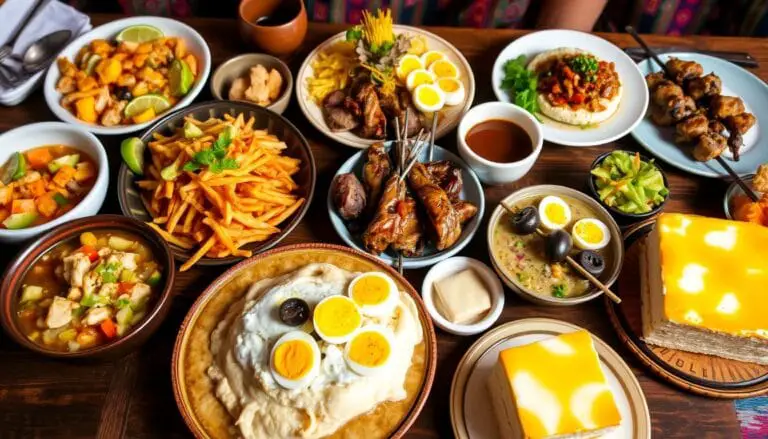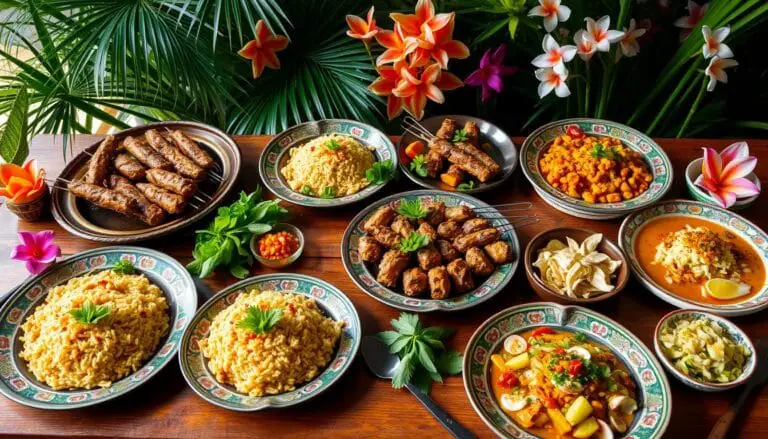Fall in Love with Peruvian Cuisine: 7 Must-Try Dishes!
This site contains affiliate links . At no additional cost to you, I may receive a commission off these links. They help fund this blog. Thanks for your support! See my Disclosure Policy for more info.
Step into the vibrant world of Peruvian cuisine for a culinary adventure. Peru’s flavors and cultural heritage make it a feast for the senses. From coastal ceviche to Andean delights, Peru is the heart of Latin America’s food scene.
In this article, we’ll dive into seven must-try Peruvian dishes. They showcase the country’s authentic flavors and cultural diversity. Get ready to explore the vibrant essence of Peruvian cuisine.
Table of Contents
The Rich Heritage of Peru’s Culinary Traditions
Peru’s Peruvian culinary journey is a fascinating mix of ancient traditions, Spanish influences, and global tastes. The country’s traditional Peruvian gastronomy has grown over centuries. It shows the cultural blend that has shaped its Peruvian food culture.
Ancient Influences on Modern Peruvian Cooking
The roots of Peru’s cooking go back to the pre-Incan and Incan times. These early cultures grew many native foods like potatoes, corn, and quinoa. These foods are still key in many Peruvian dishes today.
The Inca Empire’s farming skills and ways to preserve food helped start the Peruvian culinary journey. This journey is diverse and sustainable.
UNESCO Recognition and Global Impact
In 2011, UNESCO honored traditional Peruvian gastronomy as a World Heritage. This recognition boosted Peru’s fame as a food destination. It brought global attention to its Peruvian food culture.
Cultural Fusion in Peruvian Gastronomy
The Spanish arrival in the 16th century brought new ingredients and cooking ways. This led to a unique Peruvian culinary journey. The mix of indigenous and European traditions, plus African and Asian influences, created dishes like lomo saltado.
Peruvian cuisine is a magnificent blend of indigenous, Spanish, African, and Asian flavors, creating a truly unique and captivating culinary experience.
Understanding Peruvian Cuisine: A Melting Pot of Flavors
Peruvian cuisine is a mix of many flavors, showing the country’s rich culture and geography. From the coast to the Andes and Amazon, Peru’s food is a blend of spicy, sweet, sour, and salty. This mix has made Peru famous for its food, winning big awards like the World Travel Awards.
The secret to Peruvian food’s depth is its diverse influences. Indigenous, Spanish, African, Asian, and European traditions have shaped it. This mix is seen in dishes like seafood, mountain food, and Amazonian ingredients.
Peruvian food is deeply connected to the land and sea. It uses the country’s natural resources, focusing on sustainability and traditional methods. This is seen in the different cuisines of each region, each with its own flavors and cooking ways.
Peruvian food takes you on a flavorful journey. From the coast’s ceviche to the Andes’ lomo saltado and the Amazon’s aji de gallina, it celebrates Peru’s culture. Whether it’s street food or fine dining, trying Peruvian cuisine is an unforgettable experience.
Peru’s gastronomy is closely tied to sustainability, supporting the economy and reducing environmental impact.
| Culinary Influences | Iconic Peruvian Dishes | Unique Ingredients |
|---|---|---|
| Indigenous, Spanish, African, Asian, European | Ceviche, Lomo Saltado, Aji de Gallina | Aji Amarillo Paste, Potatoes, Corn |
Ceviche: Peru’s Iconic National Dish
Get ready for a Peruvian ceviche experience that will take you on a journey. This dish has its roots in Peru’s coastal civilizations over 3,000 years ago. It’s a true culinary treasure.
Traditional Preparation Methods
The secret to ceviche is in its preparation. Fresh seafood is marinated in lime juice. This method, used long before refrigerators, turns raw ingredients into a flavorful mix.
Regional Variations and Serving Styles
Peru’s different regions offer unique ceviche variations. You’ll find everything from seafood mixes to Black Clam Ceviche. It’s often served with sweet potato, corn, and cancha for a complete meal.
Best Times to Enjoy Ceviche
- Ceviche is best enjoyed from December to February when seafood is freshest.
- Cities like Lima, Trujillo, and Piura are known for their great ceviche. They’re perfect for a ceviche adventure.
- The National Ceviche Day is celebrated on June 28th. It’s a time of festivals, contests, and tastings across Peru.
Dive into Peru’s vibrant culture and flavors with the Peruvian ceviche experience. This iconic Peruvian national dish will amaze your senses and leave you wanting more.
Lomo Saltado: The Perfect Chinese-Peruvian Fusion
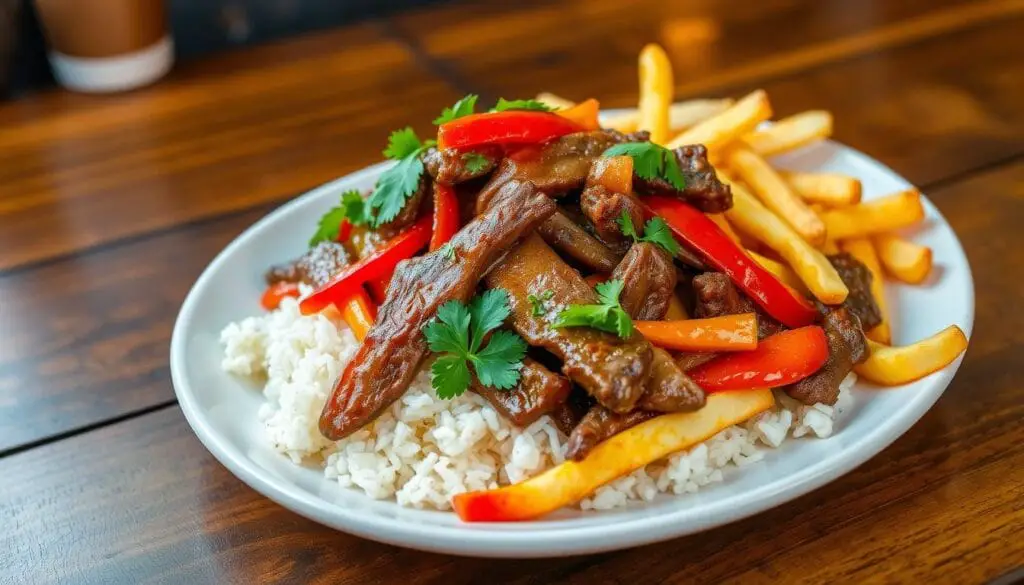
Lomo saltado is a famous dish in Peruvian cuisine. It’s a perfect mix of Asian and Peruvian flavors. This dish started in the 19th century when Chinese immigrants in Peru mixed their cooking with local ingredients.
The dish has tender beef, onions, tomatoes, and aji amarillo (Peruvian yellow chili). The beef, tomatoes, and aji amarillo create a unique taste. It’s a flavor you won’t forget.
| Ingredient | Quantity |
|---|---|
| Beef Tenderloin, NY Strip, or Ribeye | 1 lb, sliced into 1-inch strips |
| Aji Amarillo Chili | 2-3 tablespoons, minced |
| Red Onion | 1 large, sliced |
| Tomatoes | 2 large, sliced |
| Soy Sauce | 3 tablespoons |
| Oyster Sauce | 2 tablespoons |
| White Vinegar | 2 tablespoons |
| Beef Broth | 1/2 cup |
| Garlic Cloves | 3, minced |
| Cilantro | 1/4 cup, chopped |
| Yukon Gold Potatoes | 2 cups, cut into fries |
| Long-grain Rice | 1 cup, cooked |
Lomo saltado is served with French fries and rice. This shows the mix of Chinese and Peruvian cuisines. It’s a key part of “chifa” cuisine, loved in Peruvian restaurants around the world.
If you love fusion in Peruvian cuisine or want to try iconic dishes of Peru, lomo saltado is a must. It’s a journey through the flavors of Peruvian food.
Aji de Gallina: Creamy Comfort Food with a Kick
Dive into the world of Peruvian gastronomy with Aji de Gallina. This dish is a mix of Spanish and indigenous flavors. It’s a creamy chicken dish that’s both comforting and spicy.
Essential Ingredients
The key to Aji de Gallina is its ingredients. They include:
- Shredded chicken
- Aji amarillo, a vibrant Peruvian yellow chili pepper
- Aji mirasol, a sun-dried Peruvian chili pepper
- Milk or cream
- Bread, used to thicken the sauce
- Walnuts, for a subtle nutty flavor
Step-by-Step Preparation Guide
Making Aji de Gallina is a journey worth taking. Here’s how to make this famous Peruvian recipe:
- Shred the cooked chicken into bite-sized pieces.
- Blend the aji amarillo, aji mirasol, bread, walnuts, and milk or cream for a creamy sauce.
- Heat the sauce gently, then add the chicken. Let the flavors mix.
- Simmer until the sauce thickens and the chicken is hot.
Traditional Accompaniments
Aji de Gallina is often served with steamed rice. It’s garnished with black olives and hard-boiled eggs. Some people add boiled potatoes or different meats. This traditional Peruvian dish will surely impress you and make you want more.
Causa Rellena: Layered Potato Perfection
Discover the vibrant layers of Causa Rellena, a top Peruvian dish. It’s a mix of creamy mashed potatoes and savory fillings. This dish is both satisfying and beautiful to look at.
The base of Causa Rellena is a tangy potato mix. It’s made with yellow potatoes, olive oil, ají amarillo chili peppers, lime juice, salt, and pepper. This yellow layer is the start of the dish’s beauty.
- On top, you can add different fillings. These include tuna salad, chicken, crabmeat, or avocado.
- These fillings are arranged to make the dish look amazing.
- Causa Rellena can also be shaped into fun forms like rolls or balls.
This dish has a long history in Peru. It started with the Spanish arrival and the War of the Pacific. Today, it has many fillings and even vegan options, showing Peru’s diverse cuisine.
Causa Rellena is a true reflection of Peru’s culinary heritage, blending ancient Inca traditions with global influences to create a unique and unforgettable dining experience.
Try the classic tuna version or explore new flavors. Causa Rellena is a dish that will excite your taste buds. It shows the beauty of Peruvian food culture.
Exploring Street Food Delights: Anticuchos and Picarones
Peruvian street food is a must-try for anyone wanting to taste the real Peru. Anticuchos and picarones are just two examples of the amazing food you can find. They show off Peru’s rich culture and varied food traditions.
Popular Street Food Locations
In cities like Lima, Cusco, and Arequipa, the streets buzz with food smells and vendor chatter. These places are the heart of Peruvian street food. Markets, especially the Mercado Central in Lima, are famous for their wide range of street food.
Safety Tips for Street Food Enjoyment
- Choose stalls that are always busy, as this means the food is fresh and made well.
- Look for vendors who keep things clean, like using clean utensils and preparing food in clean areas.
- Go for stalls where you can see the food being cooked. This way, you can make sure it’s safe to eat.
- Follow what locals do or ask for recommendations to find the best street food spots.
Exploring Peru’s street food scene is a thrilling food adventure. It promises to excite your taste buds and make you want more of Peru’s authentic Peruvian flavors.
Must-Visit Restaurants for Authentic Peruvian Dining
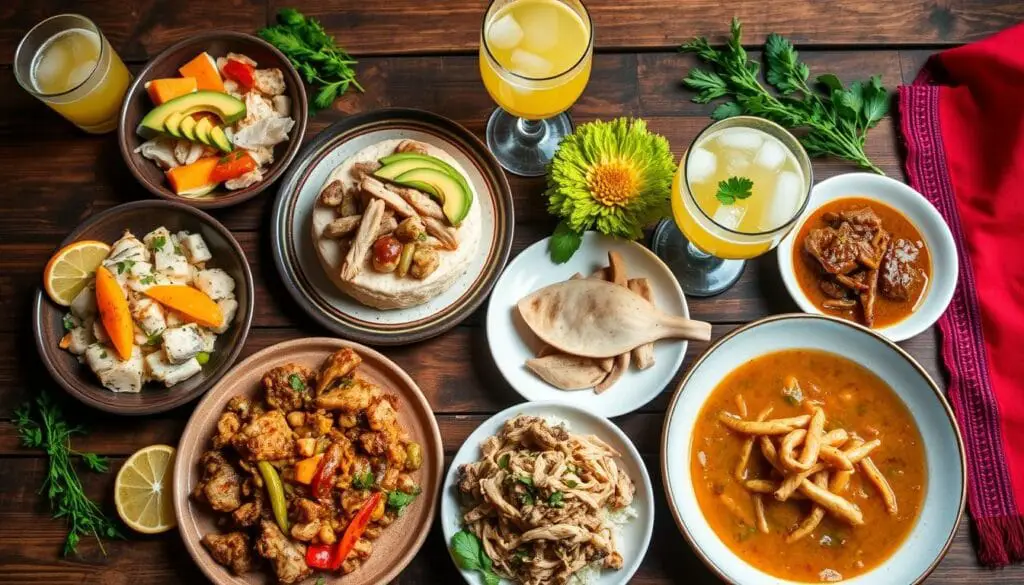
Looking for the best Peruvian food and Peruvian cuisine? These top restaurants are your go-to spots. From Lima’s lively streets to Cusco’s ancient walls and Arequipa’s quaint charm, you’ll find true Peruvian flavors here.
In Lima, Central is a must-see. It offers a tasting menu that highlights ingredients from various altitudes. Another gem is Astrid y Gastón, founded by Gastón Acurio. It mixes traditional dishes with a modern twist.
Cusco, the Inca capital, is home to Cicciolina. It serves tapas and Peruvian dishes with an international flair. Don’t miss Uchu Peruvian Steakhouse for its grilled meats.
In Arequipa, El Rincón que no conoces is a must-try. It offers authentic Arequipeño dishes. Chicha by Gastón Acurio showcases modern Arequipeño cuisine, focusing on local ingredients.
These restaurants offer a true taste of Peruvian culinary excellence, from the vibrant capital of Lima to the historic city of Cusco and the charming Arequipa.
Craving ceviche, lomo saltado, or aji de gallina? These Peruvian restaurants will delight your taste buds. They take you on a journey through Peru’s diverse and rich flavors.
Essential Ingredients in Traditional Peruvian Cooking
Start your journey through Peruvian cooking by learning about key ingredients. These include native peppers, indigenous vegetables, and grains. They have been vital to Peruvian dishes for many years.
Native Peppers and Spices
Peruvian food is famous for its bold flavors from native peppers. Aji amarillo, aji panca, and rocoto peppers bring unique heat and taste to dishes. Spices like cumin and oregano also play a big role in enhancing flavors.
Indigenous Vegetables and Grains
- Potatoes: Peru has over 3,000 potato types, making them a key part of their cooking.
- Quinoa: This Andean grain is loved for its high protein and use in salads, soups, and desserts.
- Corn: Peruvian corn, like choclo, adds special textures and tastes to traditional meals.
These local ingredients mix with Spanish, African, and Asian cuisines to create Peruvian food’s rich flavors. They show the country’s cultural richness and natural wealth. This mix makes Peruvian cooking a unique journey.
Peruvian cuisine is a melting pot of flavors, a celebration of the country’s rich biodiversity and culinary traditions.
Conclusion
Peruvian cuisine is a mix of old traditions and new tastes, creating a world of flavors. From the fresh ceviche to the warm aji de gallina, each dish shares a piece of Peru’s story. This blend of tastes has made Peru a top spot for food lovers around the world.
Trying Peruvian food is more than just eating; it’s diving into the country’s culture and history. Whether you’re in fancy restaurants or street food stalls, you’ll find a feast for your senses. It’s a journey that will make your taste buds happy and teach you about Peruvian cultural food experience.
Keep exploring the Peruvian gastronomy and be open to new tastes. Dive into the rich flavors that make Peruvian food so special. This adventure will not only fill your belly but also deepen your respect for Peru’s culinary traditions.
Check Out This Article:
FAQ
What are some must-try Peruvian dishes?
You should try ceviche, lomo saltado, and aji de gallina. Don’t miss causa rellena, rocoto relleno, and picarones. Pollo a la brasa is also a must-try.
What are the key influences on Peruvian cuisine?
Peruvian food comes from a mix of indigenous, Spanish, African, and Asian traditions. This blend has shaped its unique taste.
Why is Peruvian cuisine recognized as a World Heritage?
UNESCO named Peruvian food a World Heritage in 2011. It’s celebrated for its cultural value and global influence.
How would you describe the flavors of Peruvian cuisine?
Peruvian food is known for its spicy, sweet, sour, and salty tastes. This mix makes it both unique and delicious.
What is the national dish of Peru?
Ceviche is Peru’s national dish. It comes from coastal traditions and uses lime juice to “cook” the fish.
What is the history behind the dish lomo saltado?
Lomo saltado started in the 19th century. Chinese immigrants in Peru mixed their cooking with local ingredients, creating this dish.
What are some popular Peruvian street food dishes?
Anticuchos (beef heart skewers) and picarones (sweet potato and squash fritters) are favorites on the streets.
Where can I find the best Peruvian restaurants?
For top-notch Peruvian food, check out Central and Astrid y Gastón in Lima. Cicciolina and Uchu Peruvian Steakhouse in Cusco are also great. In Arequipa, try El Rincón que no conoces and Chicha by Gastón Acurio.
What are some of the key ingredients in traditional Peruvian cooking?
Native peppers like aji amarillo and rocoto are key. So are indigenous vegetables and grains like potatoes, corn, and quinoa.


